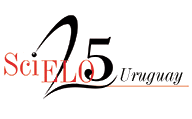Onetti, between Lavanda and Montevideo. (The construction of the analogous city)
DOI:
https://doi.org/10.25185/11.7Keywords:
Analogous city, Pseudo-real referent, Urban area, Places of memory, Rossi, OnettiAbstract
The configuration of space in the narrative of the Uruguayan writer Juan Carlos Onetti reminds certain constructional systems applied in urban design, such as the analogous city concept coined by the architect Aldo Rossi. According to Rossi, urban space can be envisioned through the superposition of different architectural possibilities, both imaginary and real, enabling the creation of a new design not existing yet. Applying this concept, this article analyzes the configuration of space in Dejemos hablar al viento, one of Onetti’s mature novels, published in 1979. The city of Lavanda, the setting of the first part of the novel, is mainly configured through references that point to the Uruguayan capital, Montevideo. These places, together with additional locations of more ambiguous origin, establish between both cities an analogous relationship, leading to a constructive model that offers new reading perspectives.
Downloads
References
Aínsa, Fernando. “Del Topos al Logos, «Grafías» del Espacio en Perspectiva”. Todas as Letras, nº 4 (2002): 59-67.
Aínsa, Fernando. Del topos al logos. Propuestas de Geopoética. Madrid: Iberoamericana - Vervuert, 2006.
Barrios Pintos, Aníbal. Montevideo. Los barrios I. Montevideo: Editorial Nuestra Tierra, 1971.
Benedetti, Mario. Primavera con una esquina rota. Madrid: Alfaguara, 1982.
Benedetti, Mario. Rincón de haikus, Madrid: Visor, 1999; México: Alfaguara, 1999.
Buck-Morss, Susan. The dialectics of seeing: Walter Benjamin and the Arcades project. Cambridge: MIT Press, 1989.
Espino, Cristina. “Santa María y la nostalgia por Montevideo”. Relaciones, nº 86 (2004). http://www.chasque.net/frontpage/relacion/0405/index.htm
Kohan, Martín. Zona urbana. Ensayo de lectura sobre Walter Benjamin. Buenos Aires: Grupo Editorial Norma, 2004.
Komi, Christina. Recorridos urbanos. La Buenos Aires de Roberto Arlt y Juan Carlos Onetti. Madrid: Iberoamericana - Vervuert, 2009.
Lynch, Kevin. The Image of the City. Cambridge: The M.I.T. Press, 1960.
Onetti, Juan Carlos. La vida breve. Barcelona: Editora y Distribuidora Hispano Americana (EDHASA), 1980.
Onetti, Juan Carlos. Dejemos hablar al viento. México: Editorial Artemisa, 1985.
Pimentel, Luz Aurora. El espacio en la ficción. Ficciones espaciales. La representación del espacio en los textos narrativos. México: Siglo XXI editores, 2010.
Prego, Omar y María Angélica Petit. Juan Carlos Onetti o la salvación por la escritura. Madrid: Sociedad General Española de Librería, 1981.
Rossi, Aldo. “La arquitectura análoga”. 2C: Construcción de la ciudad, nº 2, (1975): 8-11.
Solotorevsky, Myrna. “Referentes ficticios y «pseudo-referentes reales» en «Santa María de las flores negras»”, de Hernán Rivera Letelier”. Hispamérica, nº 97 (2004): 17-28.
Vargas Llosa, Mario. “Huellas de Faulkner y Borges en Juan Carlos Onetti.” Monteagudo, 3a Época, no 14 (2009): 15-26.
Verani Hugo J. Onetti: el ritual de la impostura. Caracas: Monte Ávila Editores, 1981.
Verani Hugo J. “Onetti y el palimpsesto de la memoria”. En Actas del IX Congreso de la Asociación Internacional de Hispanistas 18-23 agosto 1986. Volumen II, Berlín, Frankfurt am Main, Vervuert, 1989, 725-732. Alicante: Biblioteca Virtual Miguel de Cervantes, 2016. http://www.cervantesvirtual.com/nd/ark:/59851/bmc5b228
Vitale, Ida. “El otro Montevideo”. En Montevideo de puño y letra, Jorge Burel, 121-127. Montevideo: Editorial Fin de Siglo, 1992.
Vitale, Ida. “Lavanda y un nuevo símbolo onettiano”. Texto Crítico, Centro de Investigaciones Lingüístico-Literarias. Universidad Veracruzana, nº 18-19 (1980): 70-72. http://cdigital.uv.mx/handle/123456789/6934
Published
How to Cite
Issue
Section
License
Copyright (c) 2022 Aarón Lubelski

This work is licensed under a Creative Commons Attribution 4.0 International License.



























 This work is under a
This work is under a 